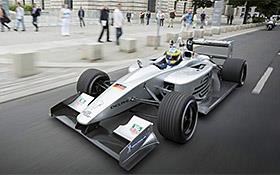 Motorsports have always been a test bed for new automotive technologies. That’s part of the motivation behind the new FIA-sanctioned Formula E racing series for electric vehicles scheduled to debut in the fall of 2014.
Motorsports have always been a test bed for new automotive technologies. That’s part of the motivation behind the new FIA-sanctioned Formula E racing series for electric vehicles scheduled to debut in the fall of 2014.
Of course, if an EV race car has to pull into the pits for extended periods of time to recharge their batteries, Formula E would get very boring very fast. So the solution that the nascent racing series has come up with to keep the race cars moving – as well as spur EV innovation – is to use wireless charging via pads installed in the track surface.
In a partnership with Qualcomm, Formula E will use the telecom company's Halo Wireless Electric Vehicle Charging system to allow an EV racer to be recharged on the fly in order to run a complete race. The wireless charging system won’t be implemented until possibly the second year of competition. During the first year, each team will be able to race replacement cars in two-segment races.
Similar to wireless charging designed for portable electronic devices such as smartphones, Halo uses resonant magnetic induction to transfer energy between a ground-based pad and a charging pad on the electric vehicle. A production EV like the Chevy Volt would require that the vehicle be parked over the base pad before automatic charging could begin.
But Formula E plans to adapt the system so that its cars can drive over the recharging pads during a race rather than having to stop and recharge. Rows of charging pads would be embedded into the surface of the racetrack. And since Formula E races are scheduled to run on short-term street circuits, the pads could even remain in place and later be used by everyday vehicles that are compatible with this type of wireless recharging.
Still to be determined are the physical characteristics of the charging pads, how they will affect the racing surface and the speed of vehicles as they pass over the pads. Speculation is that cars could be directed to a “charging lane,” similar to the way pit stops are required in conventional racing.
Formula E did not say how much time would be required for recharging. The Halo system will be tested using Formula E's safety cars during the debut 2014/2015 season.
Beyond the practicality of racers not having to stop to recharge, the FIA is also hoping that Formula E will appeal to the young, tech-savvy consumers who are prime marketing targets for EVs. After all, beyond being a test bed for new technology, the "race on Sunday, sell on Monday" mantra has long been the auto industry’s motivation behind motorsports.
[Source: FIA Formula E]
Source: MSN
No comments:
Post a Comment